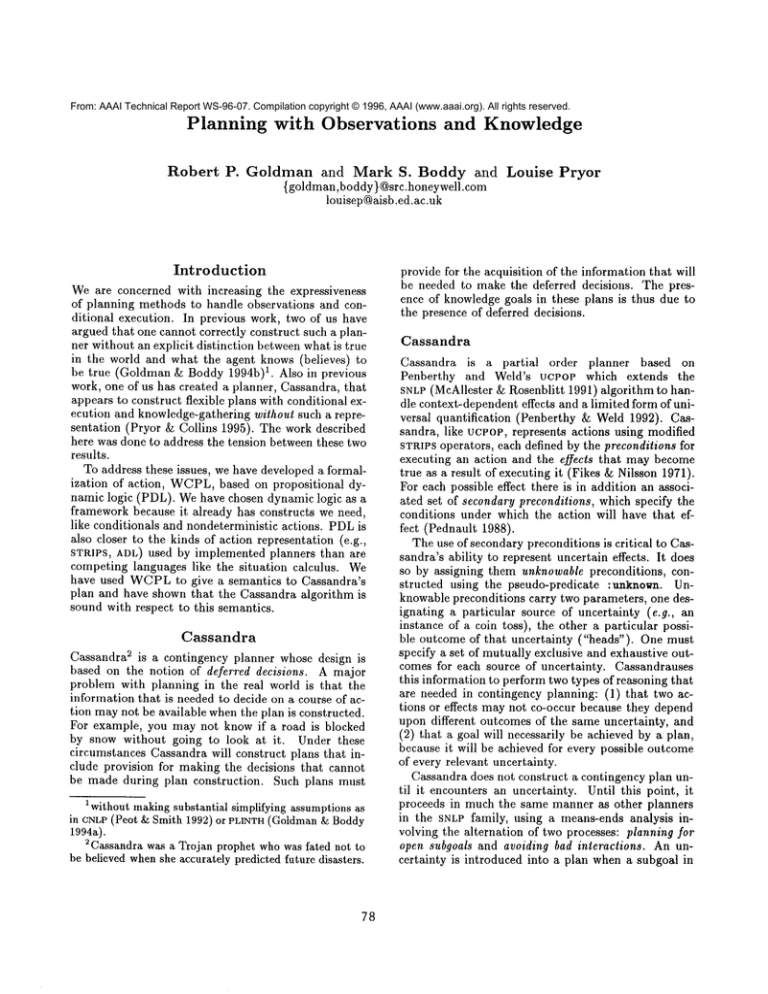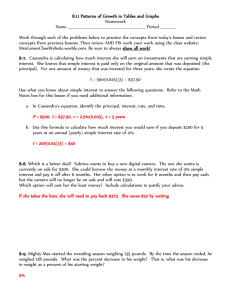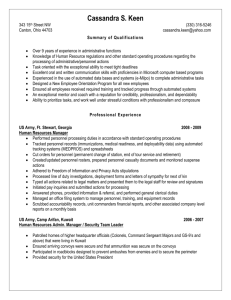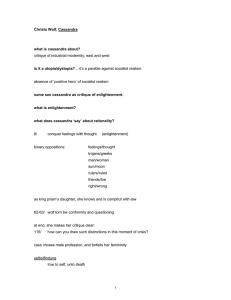
From: AAAI Technical Report WS-96-07. Compilation copyright © 1996, AAAI (www.aaai.org). All rights reserved.
Planning
Robert
P.
with Observations
and Knowledge
Goldman
and Mark S. Boddy and
{goldman,boddy} @src.honeywell.com
louisep@aisb.ed.ac.uk
Introduction
Weare concerned with increasing the expressiveness
of planning methods to handle observations and conditional execution. In previous work, two of us have
argued that one cannot correctly construct such a planner without an explicit distinction between what is true
in the world and what the agent knows (believes)
be true (Goldman &: Boddy 1994b)1. Also in previous
work, one of us has created a planner, Cassandra, that
appears to construct flexible plans with conditional execution and knowledge-gathering without such a representation (Pryor & Collins 1995). The work described
here was done to address the tension between these two
results.
To address these issues, we have developed a formalization of action, WCPL,based on propositional dynamic logic (PDL). Wehave chosen dynamic logic as
framework because it already has constructs we need,
like conditionals and nondeterministic actions. PDLis
also closer to the kinds of action representation (e.g.,
STRIPS, ADL) used by implemented planners than are
competing languages like the situation calculus. We
have used WCPLto give a semantics to Cassandra’s
plan and have shown that the Cassandra algorithm is
sound with respect to this semantics.
Cassandra
2
Cassandra is a contingency planner whose design is
based on the notion of deferred decisions. A major
problem with planning in the real world is that the
information that is needed to decide on a course of action maynot be available when the plan is constructed.
For example, you may not know if a road is blocked
by snow without going to look at it. Under these
circumstances Cassandra will construct plans that include provision for making the decisions that cannot
be made during plan construction.
Such plans must
1 without makingsubstantial simplifying assumptionsas
in CNLP(Peot & Smith 1992) or PLINTH (Goldman& Boddy
1994a).
2Cassandra was a Trojan prophet whowas fated not to
be believed whenshe accurately predicted future disasters.
78
Louise
Pryor
provide for the acquisition of the information that will
be needed to make the deferred decisions. The presence of knowledgegoals in these plans is thus due to
the presence of deferred decisions.
Cassandra
Cassandra is a partial
order planner based on
Penberthy and Weld’s ucPoP which extends the
SNLP(McAllester & Rosenblitt 1991) algorithm to handle context-dependent effects and a limited form of universal quantification (Penberthy & Weld 1992). Cassandra, like ucpoP, represents actions using modified
STRIPSoperators, each defined by the preconditions for
executing an action and the effects that may become
true as a result of executing it (Fikes & Nilsson 1971).
For each possible effect there is in addition an associated set of secondary preconditions, which specify the
conditions under which the action will have that effect (Pednault 1988).
The use of secondary preconditions is critical to Cassandra’s ability to represent uncertain effects. It does
so by assigning them unknowable preconditions, constructed using the pseudo-predicate :unknown. Unknowable preconditions carry two parameters, one designating a particular source of uncertainty (e.g., an
instance of a coin toss), the other a particular possible outcome of that uncertainty ("heads"). One must
specify a set of mutually exclusive and exhaustive outcomes for each source of uncertainty. Cassandrauses
this information to perform two types of reasoning that
are needed in contingency planning: (1) that two actions or effects maynot co-occur because they depend
upon different outcomes of the same uncertainty, and
(2) that a goal will necessarily be achieved by a plan,
because it will be achieved for every possible outcome
of every relevant uncertainty.
Cassandra does not construct a contingency plan until it encounters an uncertainty. Until this point, it
proceeds in much the same manner as other planners
in the SNLPfamily, using a means-ends analysis involving the alternation of two processes: planning for
open subgoals and avoiding bad interactions. An uncertainty is introduced into a plan when a subgoal in
the plan is achieved by an effect with an unknowable
precondition.
Whenan uncertainty has been introduced, the plan
depends on a particular outcome of that uncertainty
and the plan so far is effectively a contingency plan
for that outcome. If the plan is to be sound, contingency plans must be constructed for all other possible
outcomes of the uncertainty as well. Cassandra does
this by splitting the plan into a set of branches, one
for each possible outcome of the uncertainty. Cassandra labels the componentsin the existing plan to show
that they depend on a particular outcome of the uncertainty, and introduces a new set of goals for each
other possible outcome¯ The plan is not complete until all the goals are achieved in every possible outcome
of every uncertainty.
Each plan component is relevant only to certain
branches of the plan and is labeled accordingly. Cassandra propagates labels through the plan to indicate
both the contingencies in which elements play a r61e,
and the contingencies with which they are compatible.
Note that these are two different issues: a plan element may be compatible with a contingency, in that it
does not interfere with the achievement of any goals in
that contingency, without actually helping to establish
them. Positive labels, indicating the branches in which
a component is required for goal achievement, propagate backwards from goals to the steps that achieve
them.
Negative labels are introduced when an unsafe link
is detected: a causal link that is threatened by another
effect (the clobberer) in the plan. There are two standard methods for resolving an unsafe link in planners
in the SNLP family: separate the clobberer and the unsafe link by adding codesignation constraints ensuring
that they don’t unify; or reorder the actions in the plan
to ensure that the clobberer occurs outside the range
of the link. The first of these methods is extended
in Cassandra: another method of separating the clobberer from the unsafe link is to ensure that they only
occur in different contingencies. This method of resolving unsafe links results in plan components being
labeled with contingencies in which they may not occur. Negative labels are propagated forwards from the
problematic effect to the subgoals it establishes.
Decisions
in Cassandra
Whenan agent executes a branching plan, it must at
some point decide which branch to take. Rather than
treating this decision as an explicit part of the plan,
previous work has in effect simply assumed that the
agent will execute those steps that are consistent with
the contingency that actually obtains (Warren 1976;
Peot & Smith 1992)¯ However, in order to know
which contingency holds during execution, an arbitrarily large amount of work may be necessary in order to gather the information on which the decision
is based (Pryor 1994). For the plan to be viable the
79
planner must be able to ensure that it will be in a
position to make the decision and to guarantee that
the steps required to gather information do not conflict with those required to carry out the rest of the
plan. The approach taken in the design of Cassandra
to this problem is to treat decisions as explicit plan
steps. By doing this Cassandra can make use of its
existing mechanisms for achieving preconditions and
avoiding conflicts.
Cassandra adds an explicit decision step each time it
introduces a new branch into a plan. The decision step
is added to the plan along with ordering constraints
ensuring that it occurs after the step with which the
uncertainty is associated and before any step with a
subgoal the achievement of which depends upon a particular outcome of the uncertainty.
For a decision step to be operational, there must be
an effective procedure by which the agent executing
the plan can determine which decision to make. In
Cassandra, each decision step has associated with it
a set of rules, derived from an analysis of the uncertainty that led to the introduction of the new branch.
The action of deciding which contingency to execute
is modeled in Cassandra as the evaluation of a set of
condition-action rules of the form:
If condition1 then contingency1
If condition2 then contingency2
The executing agent can decide which branch to pursue by evaluating these rules when it comes to the decision step. Since the intended effect of evaluating the
decision-rules is to choose an appropriate contingency
for each outcomeof a particular uncertainty, the conditions are meant to be diagnostic of particular outcomes
of the uncertainty. The agent cannot directly determine the outcome of an uncertainty, so it must infer
it from the presence or absence of effects that depend
upon that outcome.
Cassandra constructs its decision rules by checking
for the effects of a given outcomethat are used to establish preconditions in the contingency associated with
that outcome. For example, in one of the two outcomesof the act of selecting a soft drink from a faulty
soda machine, the machine dispenses a drink and takes
the agent’s money. Let us assume that this action was
done as part of a plan that requires the agent to have
a drink despensed to it. Cassandra would generate a
plan containing an observation action to verify that the
soda was, in fact, dispensed.
Cassandra does not need to analyze the plan operators to identify all the effects that could be expected
to result from a given outcome of the uncertainty, and
make the antecedent be the conjunction of these effects, as the important issue is to verify only that the
contingency plan can actually succeed. 3 To return to
3This has the interesting consequencethat the executing
agent might, in principle, end up selecting a contingency
the soft-drink machine, Cassandra’s plan would not
contain an observation action to verify that the soda
machine had taken the agent’s money.
The antecedent condition of the decision-rule constructed by Cassandra is thus simply a conjunction of
all the direct effects of a particular outcomethat are
used to establish preconditions in the contingency plan
for that outcome. Decision-rules are constructed incrementally as the plan is elaborated and effects are used
to establish preconditions (Pryor & Collins 1993).
In order to evaluate a decision-rule, the executing
agent must be able to determine whether the rule’s
antecedent holds. The preconditions for the decision
step must thus include goals to knowthe current status
of each condition that appears as an antecedent of a
rule in this condition. The preconditions of a decision
step become open subgoals in the plan in the same
way as do the preconditions of any other step. In other
words, Cassandra generates a set of goals to acquire the
knowledgenecessary to evaluate the decision-rules.
4. ifPET),andAEA,
then (A) PE/)
5. eER
6. if P E 7) and P contains no sub-formula of the form
(A) P, then P? E ,4.
7. IfA, BE‘4, thenA;BE‘4
8. IfA, BEA, thenAUBE,4
A literal is an atomic proposition or its negation--if
¢ E (P, then ¢ and -~¢ are literals, e is the null action.
Weprovide the conventional extensions of notation,
e.g. A for conjunction, as syntactic sugar. Wealso
provide D as a dual for the () modality (see discussion
of semantics, below).
Semantics of PDL The semantics of PDLis defined
in terms of Kripke structures, S, written (W, r, m).
is a non-emptyset of world states. ~r is an interpretation of ~, mappingeach proposition to those states in
Win which that proposition is satisfied. ~r is extended
to expressions using the propositional connectives in
the conventional way. m is an interpretation of the singleton programs (those consisting of a single action),
mappingeach action ~ to a set of pairs of world states
denoting permitted state transitions for ~. The interpretation of programsis defined recursively as follows,
based on the relations in m:
Definition 1 (Semantics of programs)
WCPL
WCPLis an action representation
created to support the development and analysis of contingency planning systems (Goldman &~ Boddy 1996). WCPL
based on propositional
dynamic logic. WCPLhas
constructs for STRIPS-like actions, augmented with
context-dependent effects and uncertain outcomes. A
modality for knowledge permits plans with observation
actions. Using the above machinery, plans for both versions of the "bomb in the toilet" (McDermott 1987)
problem can be provided.
= {(s,s) ls e
re(P?) = {(s,s)
m(A;B) = m(A) om(B)
m(AUB)= m(A) Um(B)
PDL
Propositional dynamic logic (PDL) is a modal propositional logic designed to support reasoning about simple
programs (Hard 1984). In PDL, propositions are interpreted in the usual way. The modality corresponds
to the execution of programs; we speak of propositions
that possibly or necessarily hold after a programhalts.
PDLhas constructs for sequences, repetition (which
is not used in WCPL)and nondeterministic choice.
These constructs can be used to compose programs
(complex modalities).
’?’ can be read as ’test.’ P? limits the possible subsequent world states to the set of worlds where P holds.
’;’ denotes sequential composition of programs. Wewill
omit the ’;’ operator when doing so does not obscure
the meaning, o denotes composition of relations.
(A) P is satisfied in those worlds w for which there
exists another world w~ and a program A such that P
is satisfied in w’ and (w, ~) Ere(A). Intuitively, P is
a possible outcome of A. The dual of 0, corresponding
to necessity, [A] P maybe read as P necessarily holds
after A.
Syntax of PDLGiven a set of atomic propositions,
¯ , and a set of atomic actions, N, we define the wffs,
7~, and programs, .4, over ~ and ~ as follows:
1.
2.
~,t
3.
(1)
(2)
(3)
(4)
WCPL
WCPLprovides a representation for STRiPS-style actions, augmented with context-dependent effects and
uncertain outcomes. WCPLalso has a modality for
knowledge, that permits us to represent and reason
about action with incomplete information and about
information-gathering actions. The syntax and semantics of WCPLare drawn from PDL, of which it is a
dialect.
A simple STRIPSoperator has a set of preconditions,
7, and a set of postconditions, ~f, where both 7 and
5 are conjunctions of literals. Preconditions represent
if~EN, then~E.4
ifSE(b,
thenCCP
hen-~
ifP, P,PvQE7~
QE7
p]an even though the outcomeof the uncertainty were not
the one with which that plan was associated. Notice that
this wouldnot cause a problemin the executionof the plan,
since it wouldonly occur if all the conditions for the plan’s
success were met.
80
limits on the situations in which an action can be applied. The effects of performing an action in a state in
which its preconditions are not satisfied are undefined.
PDLcannot conveniently represent this state of affairs, because of the nature of the necessity modality. Since this is the dual of possibility, [A] P will hold
for any P if A cannot be executed successfully. Accordingly, WCPLhas a distinguished atomic proposition planfail ~ ¢. WCPLconstrains the accessibility relation over possible worlds such that executing
an action when one of its preconditions fails to hold
causes planfail to becometrue (in the initial conditions planfail will always be false), and once true,
planfail persists through all subsequent actions. Furthermore, we require that every action be regarded as
executable in any situation -- although nowthe effect
may be to cause planfail. More formally:
[A] planfail = planfail V -~7(A)
Actions in WCPLmay have context-dependent
effects and there may be uncertainty about their outcomes. WCPLrepresents context-dependent
effects
by associating with each action a set of mutually exclusive and exhaustive postcondition specifications (primitive outcomes), each associated with one of a set of
triggers. WCPLpermits actions whose outcomes are
in principle not predictable by the planner, such as
coin tosses. To handle such actions, each trigger is
permitted to have not just one outcome, but a set of
mutually-exclusive and exhaustive outcomes. Wedo
not have space to present them here, but elsewhere we
present a formalization of STRIPS-style actions, augmented by nondeterminism and context-dependent actions (Goldman & Boddy 1996).
In order to reason about the executing agent’s state
of knowledge, WCPLprovides a second modality. The
PDLsemantics is augmented by a second accessibility
relation, k, and an interpretation ~ over the worlds
(the interpretation is defined as Tr, mutatis mutandis):
The accessibility relationship is intended to hold between worlds that are consistent with the agent’s beliefs. The agent’s beliefs are founded on knowledge
of the initial state and a correct understanding of the
outcomes of actions.
Planning is the process, given a description of an
initial state, and a goal, of finding a plan that will
achieve the goal when executed in the initial state. In
the PDLframework, the classical planning problem is
posed as follows: given a goal G and an initial state
description, D, find a program, A, such that:
D --* [A] G A D, -~planfail --~ [A] -~planfail
The first condition enforces that the plan achieve the
goal, the second that actions only be attempted when
their preconditions hold.
Cassandra
plans
in WCPL
The first step in our analysis of the Cassandra algorithm is to provide an independent semantics for Cas-
sandra’s plans, using WCPL.To do so, we must translate Cassandra’s actions into WCPLequivalents, actions. Wethen translate Cassandra’s plans into sets
of WCPLprograms. The first step is complicated by
a number of factors: Cassandra and WCPLdiffer in
their representations of context-dependent effects and
uncertain outcomes; Cassandra’s observation actions
need explication; and there is no direct counterpart in
WCPLfor Cassandra’s decision nodes. A single Cassandra plan corresponds to a set of WCPLprograms
both because Cassandra’s plans are partially-ordered
and because Cassandra uses labels as a compact representation for branching plans. In this section, we
address these issues in turn, concluding with the translation of a Cassandra plan into WCPL.
Wewould like to emphasize that providing a semantics for Cassandra actions in WCPLis not a superfluous exercise. This is not a matter of providing an
alternate semantics for Cassandra’s actions: there is
no previously-existing semantics.
Cassandra’s
actions
In this section we discuss a numberof issues related to
translating Cassandra’s actions into the WCPLrepresentation, including the representation of contextdependent effects and uncertain outcomes. We also
discuss how Cassandra’s method of simplifying reasoning about knowledge and information-gathering actions may be reflected in WCPL.Weconclude with the
translation of a sample Cassandra action.
Context-dependent effects are represented differently in Cassandra and WCPL.Cassandra’s representation is an extension of that used in vcPoP(see Section ). This representation is well-suited to use in domains where there is no uncertainty, since it supports
the planner in identifying a minimal set of propositions that must be established in order to bring about
a desired effect. It does not, however, support a planner in reasoning about the correlations between different effects. 4 WCPL’srepresentation, using triggers,
is designed to support this kind of reasoning. In a
propositional setting, the expressive power of the two
representations does not differ: from a set of effects
and secondary preconditions, we may generate a set of
mutually exclusive and exhaustive triggers.
Cassandra extends UCPOP’s secondary precondition
mechanism to represent actions with uncertain outcomes. An action whose outcomes have some irreducible uncertainty, will have effects whose secondary
preconditions include a special :unknownproposition.
An advantage of this mechanismis that it facilitates
the extension of ucPoP into Cassandra.
These unknowable propositions are not propositions
like others. P~ather, they provide a methodof encoding
nondeterministic disjunction: the same state of affairs
4Weconjecture that this representational choice contributes to the kind of incompleteness we discuss in the
followingsection.
81
Definition
2 (Accessibility
relation)
= {(s,t)Is,
k(0 = {(s,s) lssW}
k(P?)--- {(s,s) I se
k(A;B) = k(A) ok(B)
k(AUB) = k(A) Uk(B)
Definition 3 (Knowledge) The knowledge modalily is defined in terms of quantificalion
worlds.
over belief-accessible
A
[A]KnowP -(A)
{sE WIVtE W,(s,t)
/x
gnowP --
{3sEWIVtEW,(s,t)
ek(A)--*tE~(P)}
Ek(A)-~tex(P)}
as is encoded by WCPL’salternative outcomes. In our
semantics for Cassandra, we will introduce disjunction
directly.
Although it is acceptable semantically to replace
Cassandra’s representation of uncertainty with the disjunction provided by WCPL,doing so does not capture the pragmatic effect of the :unknown preconditions. These preconditions serve to partition the space
of primitive outcomes into pragmatically useful equivalence classes, based on predictions of likely uses of an
action. This prevents Cassandra’s plans from unnecessary branching. This function of :unknown preconditions is the same as that of other secondary preconditions. Accordingly, for each :unknownprecondition,
we construct a partition of the primitive outcomes of
the action.
Cassandra introduces a special kind of proposition, Knowif, to represent the effects of informationgathering actions. The semantics of KnowifP are
KnowP V Know-,P. Cassandra does not explicitly
represent an agent’s knowledgestate. Instead, Cassandra can assume that agents will know the truth value
of a proposition except when this knowledgeis threatened by the introduction of an action with uncertain
outcomes that can affect the proposition in question.
Doing so requires that Cassandra be able to conjoin
the outcomes of uncertain actions with appropriate
Knowif propositions. Wewill see in the next section
that Cassandra’s decision nodes provide this mechanism.
Pryor and Collins give an example involving the operation of a faulty soft-drink machine: one that mayor
maynot actually dispense a soft drink. Their representation of a simplified version of this action is given in
Figure 1 (adapted from (Pryor & Collins 1995)).
corresponding WCPLformalism is given in Figure 2.
only a partial order over operators and decision nodes.
Given the classical assumption of sequential execution
by a single agent, any partially-ordered ("nonlinear")
plan can be treated as denoting the set of totallyordered action sequences consistent with that partial
order. Wehave developed an algorithm that characterizes the set of totally-ordered WCPLprograms that
correspond to a given Cassandra plan.
The understanding of Cassandra’s decision nodes is
complicated by the fact that these nodes serve two
purposes. First, they introduce branching into Cassandra’s plans. Second, they provide the mechanism
ensuring the appropriate introduction of observation
actions.
Decision nodes indicate branch-points in a contingent plan; their ordering determines the structure of
the resulting totally-ordered plan. Propagation of labels determines which actions are executed along a
given branch. Our algorithm provides a unique totallyordered plan for any given sequence of decisions by restricting the actions executed to those whose positive
labels subsumethe current context.
Decision nodes serve to "marshal" knowledge preconditions for Cassandra’s plans. Recall that Cassandra behaves almost everywhere as a conventional
STR.IPS planner, i.e., one with complete knowledge.
The only time when Cassandra behaves differently is
when it tries to use an uncertain outcome as an establisher. At this point the Cassandra algorithm calls for
the introduction of a decision node, which has Knowif
subgoals. The decision node acts as a point of conjunction between the uncertainty-introducing
action
and the knowledge-restoring action. Protections ensure that the action and the observation are not separated, so that the observation will function correctly.
Cassandra’s
plans
A single Cassandra plan data structure corresponds to
a set of WCPLplans, because Cassandra plans impose
In this section we prove the soundness of Cassandra’s
plans with respect to the semantics presented in the
previous section. To do so, we adapt the proof of
82
Proof of soundness
Action:
(enter-selection ?machine)
Preconditions:
(:and (money-entered 7machine)
(plugged-in ?machine))
Effects:
(:when(:and(available
?machine
7selection)
(:unknown
7okT))
:effect
(dispensed
?selection))
uneertu,n
¢~¢ct
(:when(:and(available
7machine
7selection)
(:unknown
?okF))
:effect
(:not(dispensed
?selection)))
uncertain
¢~ec~
(:when(available
?machine
?selection)
:effect(:not(money-entered
?machine)))
(:when(:not(available
?machine
?selection))
:effect(another-selection-indicator-on
?machine))
Figure 1: Cassandra and a faulty soft-drink machine.
operator:
enter-selection
preconditions(7): money-entered, plugged-in
postconditions:
available
--* dispensed, -1 money-entered(l)
-~ dispensed, -~ money-entered(2)
-~ available --* selection-indicator-on
Figure 2: Cassandra and a faulty soft-drink
soundness for UCPOP (Penberthy & Weld 1992), from
which Cassandra was derived. The proof proceeds by
defining a loop invariant such that when the planner
halts, it will have a well-formed plan that will achieve
the goal. In service of this proof we characterize two
transformations that Cassandra can perform that are
outside the realm of uceoe.
For uceoP, the necessary and sufficient
conditions
for achieving ¢ for step ~ are as follows:
1. ~ holds in the initial conditions and for each intervening action, t3, the preservation preconditions for
that action for ¢ (1-[~) hold whenit is performed; or
2. At some time prior to ~, some other action j3 is executed, and the causation preconditions for ¢ for that
action hold just prior to the execution of ~. For each
intervening action ~ between /) and ~ the preservation preconditions for that action for ¢ hold whenit
is performed.
machine, WCPLversion.
soundness here (see the full paper). We prove that
the Cassandra loop invariant holds initially and then,
by induction, throughout the planning process. The
induction step relies on two propositions that show
that the loop invariant is maintained when we insert a branch into the plan and when we insert additional steps into branches of the plan. The key to
goal achievement is that when new steps are added
to branches, additional knowledge acquisition goals
are also added, to observe each consumed proposition
whose value may be affected by a previously-occuring
uncertain action.
Completeness
Weshow that Cassandra is not complete with respect
to its WCPLsemantics. Wedo so by presenting a simple plan in WCPLthat Cassandra cannot find. This
incompleteness should not be surprising: completeness
with respect to the semantics would require that Cassandra solve the test problem in the course of generating its plans. Weconjecture that Cassandra has a
more limited form of completeness, but have yet to
prove this.
One reason for Cassandra to be incomplete is that
it cannot reason about interdependencies between its
outcomes, except in a very limited way. For example,
consider what would happen if Cassandra wanted to go
water-skiing at a mountain resort. Let us further suppose that in order to successfully water ski, Cassandra
must get to the resort and the lake must be unruffled.
These conditions are sufficient to establish ¢ in a Cassandra plan as well, but they are not necessary as they
do not cover the establishment of ¢ using a nondeterministic effect of an action.
Weneed to establish a Cassandra Loop invariant as
follows:
Definition 4 (Cassandra Loop Invariant)
If the
subgoals in the goal agenda, Ag, are met by A, and
-~planfail --~ -~ (A) planfail, then A will be a solution
to the planning problem.
Wedo not have the space to give the full proof of
83
Cassandra can only get to the resort through the mountain pass when it is not snowing, which depends on an
uncertainty, whether or not the weather is windy. The
lake is unruffled iff it is not windy. Finally, Cassandra
can observe the condition of the mountain pass.
This scenario leaves Cassandra in the tantalizing situation of being able to get to the resort, but unable to
enjoy her favorite sport. 5 Even after observing that
the pass is clear, Cassandra cannot determine that the
lake will be unruffled. However, if we axiomatize the
above situation as suggested in Section, it is a theorem
that the lake is knownto be unruffled after the agent
gets to the lake.
Webelieve that part of the reason for this incompleteness is the action representation chosen by
Pryor and Collins. The ADL-basedrepresentation does
not support reasoning about such correlations.
However, we do not believe that a complete planner for
WCPL
will prove practical. Verifying the correctness
of WCPLprograms requires us to reason about a possibly exponential number of branches. Ergo, we believe
that restricted systems like Cassandra will be a practical necessity.
Weconjecture that Cassandra is complete in a more
restricted sense. Webelieve that Cassandra is complete with respect to the two plan expansion operations discussed in the proof of soundness: the addition of new branches and the addition of new steps
to branches. Recall that when new steps are added
to branches, additional knowledge acquisition goals
are also added, to observe each consumed proposition
whose value may be affected by a previously-occuring
uncertain action. These correspond to a kind of "showme" concept of knowledge6 that may turn out to have
practical advantages in environments that are less than
perfectly modeled. Wehave yet to construct a proof,
but are actively working in that direction.
Discussion
In this paper, we have presented a formal description
and analysis of Cassandra’s planning algorithm and
the resulting plans, with particular attention to the
implications of some of the representational and algorithmic choices made in the design of Cassandra. The
restriction on reasoning about knowledgeto the application of Knowiftests on uncertain outcomes simplify
the planning model and the inference that must be
performed to determine whether a plan is well-formed,
but complicates the semantics and limits the plans that
Cassandra will find. In particular, propositions whose
truth value is entailed rather than directly observable
will never be known.
It may not be immediately obvious, and is thus
worth pointing out, that Cassandra’s operators encode
in :unknown propositions not only sources of uncer5No doubt learned from Laocoon.
6perhaps Cassandra is from Troy, Mo.?
tainty, but heuristic choices about what partitions of
the possible outcomes of an action are most suited for
planning within a given domain. These secondary preconditions serve both to encode the physics of the domain, and heuristic knowledge about planning within
that domain.
Finally, the structural freedom allowed in the decision rules applicable at a given decision node complicates both the execution model and any attempt to analyze the space of plans generated by Cassandra. The
problem is that the decision rules are not guaranteed
to be mutually exclusive, so that more than one may
be applicable. Modification of this structure to ensure
mutual exclusion should be straightforward, but would
substantially alter the semantics of the plans that are
generated.
We are pleased with the experience of applying
WCPLto formalizing Cassandra. We have provided a
clear execution model for Cassandra’s plans, that can
be taken as a point of departure for future developments. The two propositions in our proof of soundness
also provide a precise characterization of the extension
Cassandra makes to vcPoP. Having a language that
provided facilities for reasoning about program execution and for the knowledge of the executing agent was
a material assistance to us in this task.
Webelieve it to be both possible and fruitful to show
that Cassandra is complete, in the restricted sense that
Cassandra will find any plan in the set of those plans
recognized as well-formed by Cassandra. This is a significant restriction from the set of all plans that are
well-formed in the WCPLtranslation of Cassandra’s
planning language, given the traditional semantics for
knowledge.
References
Fikes, R. E., and Nilsson, N. J. 1971. Strips: A
new approach to the application of theorem proving
to problem solving. Artificial Intelligence 2:189-208.
Goldman, R. P., and Boddy, M. S. 1994a. Conditional linear planning. In Hammond,K. J., ed., Artificial Intelligence Planning Systems: Proceedings of
the Second International Conference. Los Altos, CA:
Morgan Kaufmann Publishers, Inc.
Goldman, R. P., and Boddy, M. S. 1994b. Representing uncertainty in simple planners. In Doyle, J.;
Sandewall, E.; and Torasso, P., eds., Principles of
Knowledge Representation and Reasoning: Proceedings of the Fourth International Conference (KR94).
San Mateo, CA: Morgan Kaufmann Publishers, Inc.
Goldman, R. P., and Boddy, M. S. 1996. Expressive
planning and explicit knowledge. In AIPS-96.
Harel, D. 1984. Dynamic logic. In Gabbay, D., and
Guenther, F., eds., Handbookof Philosophical Logic,
volume II. D. Reidel Publishing Company. chapter
II.10,497-604.
McAllester, D., and Rosenblitt, D. 1991. Systematic
nonlinear planning. In Proceedings of the Ninth National Conference on Artificial Intelligence, 634-639.
Cambridge, MA: MIT Press.
McDermott, D. V. 1987. A critique of pure reason.
Computational Intelligence 3:151-160.
Pednault, E. 1988. Synthesizing plans that contain actions with context-dependent effects. Computational Intelligence 4(4):356-372.
Penberthy, J. S., and Weld, D. S. 1992. UCPOP:
a sound, complete, partial order planner for ADL.
In Nebel, B.; Rich, C.; and Swartout, W., eds.,
Principles of Knowledge Representation and Reasoning:Proceedings of the Third International Conferenee, 103-114. Los Altos, CA: Morgan Kaufmann
Publishers, Inc.
Peot, M. A., and Smith, D. E. 1992. Conditional
nonlinear planning. In Hendler, J., ed., Artificial Intelligence Planning Systems: Proceedings of the First
International Conference, 189-197. Los Altos, CA:
Morgan Kaufmann Publishers, Inc.
Pryor, L., and Collins, G. 1993. Cassandra: Planning
for contingencies. Technical Report 41, The Institute
for the Learning Sciences, Northwestern University.
Pryor, L., and Collins, G. 1995. Planning for contingencies: A decision-based approach. Unpublished
manuscript.
Pryor, L. 1994. Opportunities and planning in an unpredictable world. Technical Report 53, The Institute
for the Learning Sciences, Northwestern University.
Warren, D. H. 1976. Generating conditional plans
and programs. In Proceedings of the AISB Summer
Conference, 344-354.
85







